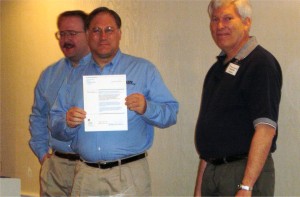|
Private
Space Takes Off
In my review of Space
Access ' 03 I reported that the private space transportation
companies had begun to move past viewgraph dreaming and were starting
to "get real". This year the reality of such an industry
was taken for granted.
The SpaceShipOne
is licensed and flying, XCOR
got its license during this very conference, and several other companies
are designing, building, and testing hardware. While far from a
mature industry, the existence of a group of viable enterprises
developing low cost space access systems can no longer be denied.
A major emphasis of the meeting dealt with how to insure that the
industry grows out of this toddler stage and into a healthy adolescence.
While hardware designs and optimizations remained topics of spirited
discussion, the hard issues of regulation, liability, legislation,
and policy strategies have become of paramount importance. The industry
must overcome these challenges if the launch companies are to make
the profits required to sustain their growth and to develop subsequent
generations of increasingly capable vehicles.
As noted last
year, suborbital spaceflight was the focus for manned vehicle development
by the commercial companies. SpaceX,
which did not participate in the meeting, was often mentioned with
regard to orbital access for unmanned cargo delivery.
While most of
the organizations have obtained or are still seeking the angel investor(s)
who will provide a plentiful and uninhibited supply of cash, other
sources of funding slowly seem to be developing. DARPA and Air Force
money as well as state grants and tax credits
have helped several companies. Memorabilia and educational/scientific
payloads look to become significant secondary markets.
Exhibitions
and competitions like the X PRIZE Cup could become a good business
as well, especially if big time sponsors become involved. Space
tourism remains the pot of gold at the end of the rainbow but only
if the regulatory and liability obstacles can be surmounted.
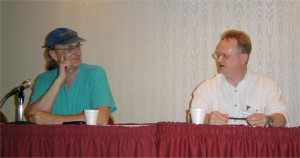
Henry Vanderbilt & David Salt It was great
fun to meet new Space Access conference participants like Alan
Boyle of MSNBC and Michael
Mealling of Rocketforge and to see again the many SAS regulars.
It was heartening to hear from a number of people that they regularly
visit RLV News.
The meeting
as always was well organized by Henry Vanderbilt and he put together
a dynamite list of speakers. Below I give brief sketches of the
meeting.
Highlights
The announcement of the RLV mission license for XCOR
was certainly the high point of the meeting if not of the whole
Space Access conference series. (See XCOR
Press Release * Alan
Boyle's report) Last fall it was announced
that the XCOR application was "sufficiently complete",
which meant that AST must either issue a launch license within 180
days or notify Congress why it failed to do so.
April 23 was the last day of that waiting period and so
everyone was expecting an announcement. I don't know about
other people but I assumed it would come out of Washington. So it
was a very pleasant surprise when George Nield of AST did an "and
by the way" at the end of his talk and ask Jeff and Randall
to come up for the license.
Congratulations to the XCOR team.
New Concepts
John Powell
of JP Aerospace
reviewed the many projects the organization is pursuing with rockets,
high altitude balloons, and airships. The Air Force has funded the
development in the past two years of huge V-shaped airships that
could provide the military with reconnaissance platforms. Sounding
rocket flights have also been funded by the Air Force. Another focus
of JP Aerospace has been high altitude stable platforms from which
rockets could be launched.
John revealed for the first time that the primary long term goal
of this diverse array of projects is to develop an airship
that will go all the way to orbit. The 6000ft long V ship
would start from a high altitude "Dark Sky Station" at
200k ft. Using electric propulsion, the vehicle would gradually
gain speed and take advantage of the slight lift provided by the
residual atmosphere even at such high altitudes. Simulations show
such a vehicle could obtain orbital velocity in about 5 days.
See images of their handout at Michael Mealling's Space
Access Pictures.
[Update April 29: See JP
Aerospace: Airships to Spaceships.]
Len
Cormier discussed his
concept for a vehicle that would pull a huge kite to high altitudes
using fuel obtained from a gondola. Released from the gondola the
vehicle would go to orbit while the kite would return to earth.
[May 3, 04 - Len Cormier posts his slides on Space
Van 2008: Kite-assisted SSTO ]
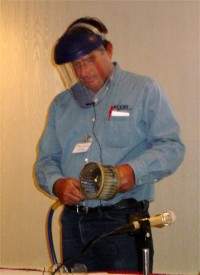
John Hare demonstrates a low cost pump concept.
Hardware
Dan
DeLong and Aleta Jackson of XCOR
reviewed the history of the company and its focus on reliable and
robust rocket
engines. They also reviewed the EZ-Rocket
project. The current emphasis is on an 1800lb
engine and the piston
pump, which has been funded by a DARPA contract. They are also
applying for a patent on a composite LOX tank that came out of technology
developed at Rotary Rocket.
Not much was
said about the Sphinx vehicle (see Alan Boyle's article)
that received the license from the FAA. It will serve as an intermediate
vehicle before building the Xerus.
With the license they will now have a better chance to obtain the
funding to build it.
Armadillo
Aerospace - John Carmack reviewed the tough challenges
of the past year - first with difficulties in obtaining high purity
H2O2 and then with finding a suitable launch site. They switched
to a mixed propellant (H2O2 and alcohol) that provides a good solution
to their propulsion needs.
For a spaceport
they switched from Oklahoma to White Sands in New Mexico. However,
their parachute return system could in extreme cases bring the vehicle
down outside the boundaries of the base. So they are switching back
to a powered landing approach that will limit the area where they
could possibly drift.
Due to the various
delays he doesn't expect to accomplish an X PRIZE attempt before
the deadline, though they may do high altitude flights by the end
of the year. If the SS1 wins the prize, they will switch back to
a focus on one man vehicles.
TGV
Rockets - Pat Bahn showed a video on the DC-X and
explained that TGV would take the vertical-takeoff, vertical landing
concept that the DC-X demonstrated and develop a commercial system.
Rocket
Guy Brian Walker had various personal problems in
the past couple years and was distracted from his rocket project.
However, in the past few months he has returned to the project and
made progress with various support systems such as a H2O2 distillation
facility and a centrifuge. He is even building a 6g rocket sled.
He said he expects to do a test flight of the rocket later this
year.
George
W. Herbert gave two talks. The first dealt with very
low cost ELVs to deliver bulk cargo such as water and fuel to LEO.
Since the failure to deliever such payloads would be no great loss,
the lower reliability of ultra-cheap expendables could be acceptable
and provide for very cheap flights.
In his second
talk, "Orbital Space, Plain", he reviewed space capsule
designs and suggested that small, low cost versions could fly on
smaller, cheaper vehicles than the EELVs as currently planned by
NASA. He even said a one man capsule project could be developed
and launched on the SpaceX
Falcon I for around $20M.
Leik
Myrabo
of
RPI reviewed beamed
propulsion projects around the world and urged people to attend
the 3rd International
Symposium on Beamed Energy Propulsion, which he is organizing.
He is continuing to pursue his Light
Craft project and other beamed propulsion concepts with his
students. However, money shortages are delaying progress.
Henry
Vanderbilt and Dave Salt reviewed projects in the US
and Europe that were not represented at the meeting. Blue
Origin, for example, is hiring but not talking except to say
that it is pursuing a suborbital vehicle.
Dave said that
a new 35M euro ESA project has been initiated to study various technologies
that could lead to an RLV in the 2020 time frame. He also mentioned
that Alan Bond's Reaction
Engines company is staying alive on small grants from private
investors and government sources. A study of the crucial heat exchanger
component seems to have been successful.
Other
hardware :
- ERPS
team discussed their various projects,
including systems to produce high purity H2O2.
- John
Hare presented his ideas for air breathing propulsion
using a turbine based combined cycle engine. (Write
up posted on sci.space.policy.)
- Andrew
Knight introduced the design of his Rotating Spindle
Pump that would be simpler and more robust than turbopumps yet
provide similar performance.
Companies
& New Marketing Ideas
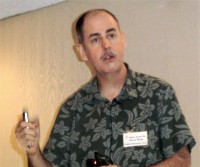
Dennis
Wingo of Orbital
Recovery Corporation.
Peter
Diamandis reviewed the history and status of the
X PRIZE. Champ
Car recently became a "presenting
sponsor" and contributed a "seven figure" donation
to the organization. More sponsors are in the works.
He then focused
on the X
PRIZE Cup. The Cup event could start as early as 2005 with exhibition
flights. Competitions would start in 2006. The
14 day event would involve many rocket flights per day and be combined
with a Champ Car race, high power rocketry competitions, and other
events. The RLV competition categories could include fastest turnaround
time, max altitude, etc..
Peter
Diamandis also presented the status of the Zero
Gravity Corporation.
The commercial parabolic flight service should finally begin service
this year. One plane is ready and another is in preparation. The
price for a seat will be $2950. To reserve the whole plane you will
need $79,500. They will base the company in Miami and later have
a second operation running out of Las Vegas.
Joan
Horvath
of
Global Space
League and Takeoff
Technologies urged that the launch companies seek out science
and education payloads as additional markets for their vehicles.
She recently published an article
in Scientific American about the new private launch companies and
found that few scientists had heard of such companies or programs
like the X PRIZE.
Dennis
Wingo
presented
the status of Orbital
Recovery Corporation, which is developing a space tug. The tug
will dock with communication satellites that are disabled or nearing
the end of their station keeping fuel and it provide propulsion
to save or extend the life of the satellites. There are over 200
comsats that will near the end of their working lives by 2012. The
tug will use highly efficient electric propulsion to provide several
extra years of service.
The company
is working mostly with European companies and ESA. The first flight
could occur by 2007. The tugs will launch as secondary payloads
on the Ariane V. The existence of such a tug should reduce insurance
costs since it will reduce the risk of total loss of a satellite
if it develops a propulsion problem.
Joe
Latrell of Beyond-
Earth Enterprises in Colorado Springs reported on their recent
launch of their first large sounding rocket. They plan to launch
every six weeks, each time with a bigger vehicle that will go to
a higher altitude. They expect to reach 100km in the autumn. To
pay for their program they provide the opportunity to fly memorabilia,
student experiments and other payloads. Packets can be obtained
via their on
line store.
TOSPACE
chief Laurie Wiggins again presented her company's business of sending
memorabilia, sci-fi paraphernalia, and other items to space and
back to enhance their value. They had one flight so far and are
looking for more rides to 100km suborbital.
Legislation,
Regulations, Liability, & Space Policy
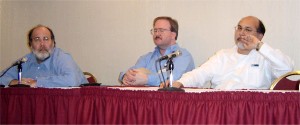
Jim Muncy of
Polispace, Jeff Greason of XCOR,
and Pat Bahn of TGV Rockets
in a panel discussion of liability issues.
Liability
panel discussion began
with a review by Jim Muncy on why space and aviation insurance systems
are so different - mostly due to the different treaty obligations
and to the small size of the space market. Other items discussed
included:
- Insurers
are accustomed to $100M per launch systesm and don't know how
to deal with low cost suborbital vehicles.
- There are
only about 8 major insurers in the world for launch systems.
- XCOR obtained
insurance to fly the EZ-Rocket for $7000 per year.
- Launch risks
are shared for third parties (i.e. the "uninvolved public").
The companies must obtain insurance for "most probable loss"
(MPL) up to $2.2B. The government indemnifies for losses above
that.
- Simply obtaining
factory floor insurance, so-called "slip and fall" policies
have been very hard to obtain for the launch companies. The mere
word "rocket" scares them off. (One company has been
turned down by 22 insurers so far.)
- Second party
insurance (i.e. paying passengers) is a big question mark. Uncertain
whether any waiver can truly protect a company from lawsuits.
- Pat Bahn
suggested that Commerce or AST fund a study of the liability issues
for manned RLVs.
Jeff
Greason
of
XCOR gave a tutorial
presentation on the steps required to obtain a launch license. Items
that he emphasized included:
- Both the
vehicle and the launch site need separate licenses.
- Environmental
impact studies involve significant effort and time. Avoid "green
field sites" if at all possible. Either use a site that already
has a license or has legacy advantages like an old military base.
- The 15 second
burn time limit for amateur rockets is an arbitrary limit set
for historical reasons related to the early development of model
rocketry. Can get waivers but this rule should eventually be eased
to allow for a testing phase without all the red tape.
- The experimental
permit specified in the pending HR3752 legislation would be a
big help.
- One of the
biggest headaches was proving that if the vehicle lost power/control
at any time during the flight, the impact zone on the ground would
never include a significantly populated area.
George
Nield reviewed the history of the FAA-AST
office and its dual assignment to regulate and promote the launch
industry. He discussed the difficulties of modifying existing regulations
such as the 15 second rule. Takes up to a year to change a rule
like that.
Pat
Bahn gave a brief overview of the Suborbital
Institute. During May 17-18 there will be another Suborbital
Action Days campaign to inform Congressional staffers on issues
of importance to the industry.
Jim
Muncy
gave
an overview of space policy, regulation, and legislation. He focus
particularly on the HR3752
act that was passed by the House and is now in the Senate. Will
probably be modified but has some chance of passing if it can ever
get a vote. [Apr.29.04: For more info about Jim's talk, see A
Legislative Breakthrough - Rand Simberg - Apr.28.04]
Rick
Tumlinson of the Space
Frontier Foundation discussed space advocacy, space policy issues,
why he hates the term "space tourist", and upcoming alt.space
meetings. The annual October meeting this year may include a one
day Space Access session to act as a 6 month update on this meeting.
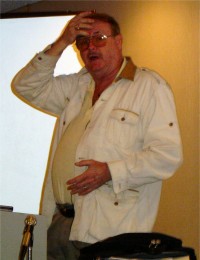
Jerry
Pournelle
Jerry
Pournelle presented
a spirited review of the history of the DC-X and other X projects
and how they should be the model for vehicle development projects.
DON'T use them to develop new technology but rather to combine current
technologies so that they accomplish something new, e.g. exceed
the sound barrier or demonstrate low cost operations for a rocket
vehicle.
He advocated
the use of large prize awards for projects such as a manned lunar
base rather than funding NASA to do them. The "huge standing
army" just absorbs the money and accomplishes very little.
Brant
Sponberg of NASA reviewed the new space exploration initiative
and then focused on the Centennial
Challenges prizes program. There will be a workshop in June
to discuss possible competitions for the awards. Currently they
are limited to $250k per award. Congressional approval will be needed
for bigger awards.
The competitions
will avoid complex rules, must be at the right level of difficulty,
and the results must show some benefit to NASA's exploration plans.
Some of the suggestions so far include a better astronaut glove
(suggested by Rand Simberg), precision landing, autonomous drill,
and very low cost suborbital launches for science.
Tutorials
Henry
Spencer gave two extensive review talks. The first -
"The Other Half of the Problem: Beyond LEO" - looked at
orbital mechanics and spaceflight considerations as one moves out
from LEO. Topics ranged from radiation intensities, Hohman transfers,
geostationary orbits, Lagrange points, Lunar resources, inner solar
system, asteroid mining, and onward to the stars.
The second talk
surveyed the various spaceports around the world. No one spaceport
provides the ideal launch site for all orbits. For example, trying
to find a good spot at 0 degrees lattitude for equatorial orbits
not as easy as you might expect. Sea Launch, in fact, decided to
tow their own launch pad to get a good spot.
Barbara
Thompson of NASA gave a nice introduction to Space
Weather. This is an important for preventing damage to satellites
and even to power distribution systems on the earth from large solar
flares and coronal mass ejections. In addtion, keeping space travelers
safe will become an increasingly important task as more and more
people stay longer and longer in space.
Jeff
Greason - see the entry above about his intro
to RLV licensing.
Updates
May 3.04 - Len
Cormier posts the slides to his presentation on Space
Van 2008: Kite-assisted SSTO
April 29.04 - Added links to JP
Aerospace: Airships to Spaceships.
April 28.04 - Added links to Rand's posting.
April 28.04 - added entries on the tutorials.
|


